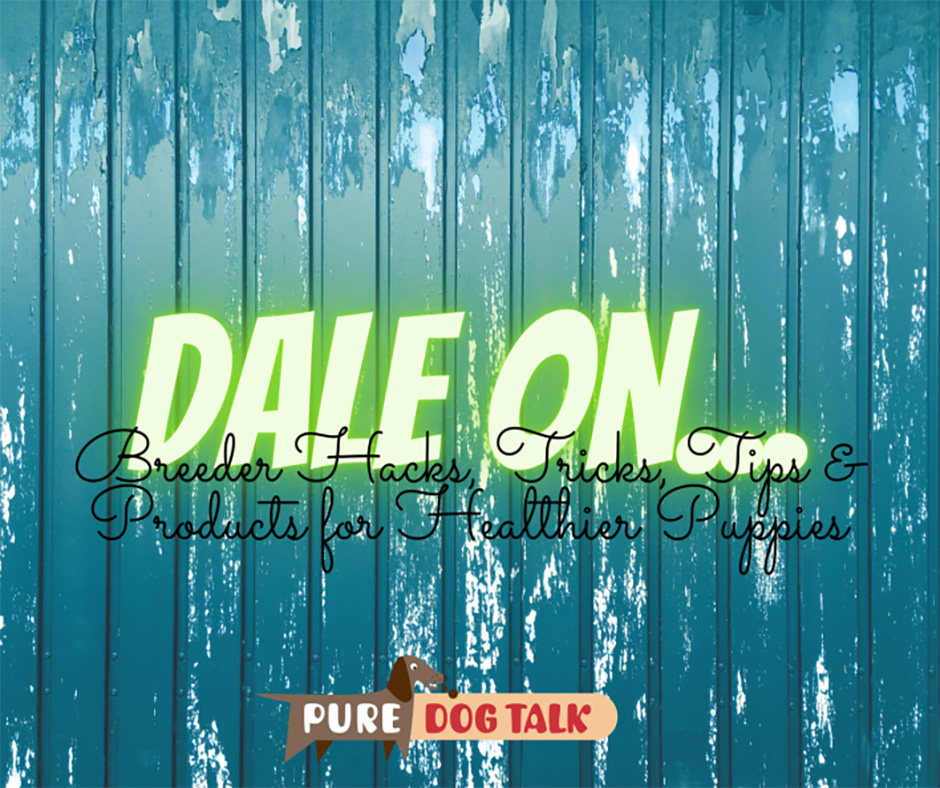649 – Veterinary Advice on Free Whelping Following C-Section
Veterinary Advice on Free Whelping Following C-Section
Dr. Marty Greer joins host Laura Reeves for a deep dive on the question of when your female has had a C-section and you breed her again. Is it safe to have the bitch whelp her puppies naturally? This question comes from a listener request.
“The most important thing to ask is why did you have a C-section in the first place,” Greer said. “If you had a C-section in the first place, because she’s a Bernese Mountain Dog or because she’s a Bulldog or a Frenchie or maybe a Clumber or a Corgi, some of the breeds that are more commonly having their puppies by c-section, you still have a Clumber or a Bulldog. They didn’t change breeds while they were pregnant, so that’s the most important reason.
“Secondly. What were the other reasons? Did she just have too many puppies? If she had 14 and she’s going to have eight this time, yeah, that’s a whole different conversation. If she had a puppy that was oversized or misdirected, that’s a different conversation. But it’s going to depend on what happened previously. So you really need to have a good history on what went on when this last C-section was done.
“Statistically, according to the numbers, 75% of the time the bitch has the C-section because of a bitch cause and 25% are a puppy cause. So that kind of gives you some numbers to work with is 3/4 of the time you’re probably going to need another C-section, but 1/4 of the time it was an anasarca puppy, it was a misdirected puppy, it was oversized, it had some other kind of a birth defect, two were coming at the same time, so you had a log jam. I mean you just have to try and sort that out.
“That’s the general thought. It’s “V-back” on the human side, it’s vaginal birth after C-section, V-back. So most of the time you absolutely can go ahead. From a safety perspective, there’s reason to believe that it’s going to be unsafe. You assume that the veterinarian did a nice job closing the uterus.
“What I always kind of laugh about is when veterinarians say, ‘ohh, the uterus was paper thin when I did her C-section. You can never have another litter.’ OK, you take a uterus and you put 14 puppies in it and you stretch it out like a pair of old pantyhose and you wonder why it’s paper thin. It’s supposed to be thin. That’s the way your stomach looks after Thanksgiving dinner. That’s the way your bladder looks when you need to go to the restroom. That’s the way the organ works. It stretches out and it becomes thinner, but that doesn’t mean that it’s so thin that she can’t have a normal pregnancy and a normal vaginal birth.”
619 – Puppy Evaluation System Developed by a Woman Ahead of Her Time
Puppy Evaluation System Developed by a Woman Ahead of Her Time

Virginia Apgar, who named the newborn evaluation system.
Dr. Marty Greer, DVM joins host Laura Reeves for their ongoing puppy discussion. This month Greer shares the story of Virginia Apgar, who named a now-famous newborn evaluation system after herself.
Apgar was a human anesthesiologist who graduated from medical school in the 1930s, Greer noted.
“She was the first female anesthesiologist admitted to the College of Anesthesiology back in an era where there were no women doctors. There were no women a lot of things. So she was truly remarkable, Greer said.
“In that era, a lot of babies were born to mothers that were sedated or anesthetized. And so (Apgar) developed a scoring system to analyze the babies and it has stuck for the last 70 years and it’s very impressive that it’s something that people talk about every day, still using the word APGAR. The acronym stands for: appearance, pulse, grimace, activity and respiration.”
The system was adapted for small animal veterinary use by a vet on staff at the University of Minnesota.

Parameters for APGAR scoring.
“The advantage of a numerical score,” Greer added “is that it gives you something that you can measure and compare litter to litter, puppy to puppy within the litter over the course of time. And we have some really good data from Neocare, which we talked about last time, about what the relationship with the APGAR score and the survival of these puppies will be. So it’s actually super cool that you can take all this information and turn it into something that you can use at home, you can use at your veterinary clinic, and that your veterinary clinic can help you with. So I would encourage people to learn to do APGAR scores. It’s not hard, it’s not mysterious. It’s really pretty straightforward on what to do with it.

Treatments for common whelping issues.
“The value of this is when you go home (from a csection, for example) and you have a puppy that had an APGAR score of a four and a puppy that had an APGAR score of a nine, that you know the puppy with the four needs a lot more attention to have the kind of survival rates that one would hope for. We always hope for a hundred percent (survival), but reality is 100% is probably not a realistic goal.
“Each of the five parameters, appearance, pulse, grimace, activity and respirations gets a score of a zero, one, or a two. So collectively, if you get twos on all five of your items, you have a score of a ten.
“It’s really simple to do. It doesn’t require high level assessment and like I said, a lot of us probably are intuitively already doing this. When you have puppy born, if it’s fish breathing and gasping and gaping, that’s not good. But, if it’s got nice pink color and it’s wailing and it’s crying and it’s wiggling and it’s pink and it’s all those things, you know that you’ve got a puppy that’s in pretty good shape. But it’s just nice to be able to give it a more numerical sign because that gives you data to work with.
“The average puppy is gonna be seven and up. It does give you a numerical score. The value of this is knowing that from the Neocare information, that’s from the University at the Toulouse -France Veterinary School, the puppies with an APGAR score of less than seven have a 22-fold increased risk of death in the first eight hours after they’re born.
“And they also know that puppies with APGAR scores between a four and a seven can achieve a 90 percent survival rate with the appropriate interventions. So, what does that mean? That means you suction them, you put them in oxygen, you make sure that they’re staying warm. You’re doing all those things that you already have been trained to do to help with puppy resuscitation so that they’re not just you know laying in the whelping box kind of hoping that they do okay.”
Greer’s seminal book “Canine Reproduction and Neonatology” is available HERE.
563 – New Tufts University Course: Breeders Teaching Veterinary Students
New Tufts University Course: Breeders Teaching Veterinary Students
Gale Golden and Susan Patterson join host Laura Reeves for a conversation about the new and exciting AKC Tufts Whelping Program that provides information to veterinary students about dog breeders.
Golden, the AKC coordinator for the program, said that the growing difficulties with finding breeder-friendly veterinarians was a huge concern for her.
“As breeders, we’ve faced many challenges and still face many challenges continuing our right to breed dogs here in the United States,” Golden said. “And one of the biggest challenges has been not only the lack of veterinary care, but the lack of understanding of the purebred, responsible dog breeder and how we work and operate. And that has led to, in some instances, lesser care breeders have available to them or even, in emergency situations, outcomes that weren’t the desired outcomes.”
Change the Conversation
Patterson, who has worked with a similar program at the Ohio State University, noted that “we need to change the conversation at the vet school level. How do we show that students, who most likely have never whelped a litter, will never do anything but triage, what a responsible breeder does, what their parameters are, how they make their choices, and how do they whelp their puppies.
“So, we are going directly to the students, who have some pre-formed opinions, but they have no experience. And we are sharing super transparently all the good, the bad, the ugly. We’ve worked with (the staff advisor) to develop what they call a selective, which in normal academic terms would be called an elective. They get to choose. And so, this last semester we had three students, this semester will have five.
“The other thing we’ve done that I think has added tremendously is we’ve not just focused on these students, but we have opened up our monthly roundtables to all interested vet students and we have brought in veterinarians. We had them in the classroom and we did have a virtual crop and dock just because of timing.
Talk About the Hard Things
“So, we’ve addressed the hard things. We’ve talked about what it takes to produce a puppy that is going to be healthy. And why we do the testing, why we make the choices, why temperament and different breeds. And so they’ve been able to ask us really hard questions. And I think the interaction has been very positive.”
“The total lack of understanding of what a purebred dog was and how they came to be and why they came to be” was an “aha” moment for Golden. She noted that one of the important topics covered in the course is the breed standard. “What is the breed standard and how did it come to be. The fact that they didn’t know was a real aha for me.
“The other thing I don’t feel like they really understood was how we preserve a breed. And as I’m sure most everyone here knows, French Bulldogs have been just bombarded with every kind of influence from outside the breed gene pool there could be. And it’s like a breed being attacked on steroids, you know, from fluffy to pink. It all exists. One of the scary statistics for this breed is last year there were 32,000 Frenchie litters registered with the AKC. 294 were parent club members, 294 out of 32,000. And since DNA really can’t accurately show us exactly what’s behind a dog, after a few generations of breeding to Frenchies, it looks like it’s a purebred Frenchie.
“Another aha for me was the health testing process, the Orthopedic Foundation for Animals, that it exists. What kind of data was there, who loads that data and that it is a partnership with veterinarians and breeders that actually populates that database and how we use it to make improvements. So those things were major ahas for me.
“The preservation message, however, is one that resonates for us. We don’t tell our own story. You know, we’re kind of invisible. There might be 90,000 of us in Massachusetts playing dog sports, but I find out legislatively many times we’re invisible. You know, the fact that we let other people tell our story is a problem.”
458 — Dog Breeding: Back to Basics with Dr. Marty Greer
Dog Breeding: Back to Basics with Dr. Marty Greer
Dr. Marty Greer joins host Laura Reeves for a review of breeding basics for our bitches. How old? How often? How many Csections? What about an oops? We start with these basic questions and detour into deep dives on critical micronutrients, breed specific cysts, what dog bodies are most difficult for abdominal surgeries and much more of the fascinating exploration of knowledge with one of the country’s pre-eminent canine reproductive specialists.
At what age should I breed my bitch for the first time?
That depends on the breed. If it’s a breed that needs to have hips X rayed after the age of two, then after the age of two is appropriate. A lot of people want to wait until the bitches are older, either because they want to see what kind of health problems they have or the bitch may have a career… when we start to see people breeding when (the bitch is) six or seven years old for the first time, we struggle a lot with fertility. So my recommendation is to not wait too long. If you have a breed that you can do hips early on or don’t need to do hips or you don’t worry about seizures when they are five, then breeding young is fine.
I like to breed young bitches with a shiny pink healthy new unused straight off the showroom floor kind of not beat up and bedraggled when she’s seven years old and now you want to use this really valuable frozen semen. Please don’t do that. The higher the stress of the semen, like frozen and fresh chilled, the younger and more fertile the bitch needs to be. We can’t have a subfertile male and a subfertile female and expect to have a good outcome.
I don’t like breeding on the first heat cycle for a couple of reasons. One is they tend not to be a fertile cycle. Two is the bitch tends not to be mature emotionally or psychologically. And three is she tends not to be physically mature. So I think that pushing to breed on the first heat is not a great idea. That does that mean it doesn’t work … plenty of bitches that plan their own breedings with their own stud dogs in their house. That may have been the breeding that you planned to do after she turned 2 and she and he decided that they would preemptively do a strike.
What happens if my bitch has an accidental breeding?
You know when you get an accidental breeding, statistically it’s 62% that get pregnant 38% don’t. There are methods to interrupt those, but I generally recommend against them unless it’s a really strong reason, like a brother sister or something along those lines. We have a lot of people who are embarrassed in their breed club, they’re worried that people are going to drum them out. If someone tells you, and they have males and females that are intact in their homes, and they tell you ‘I have never had that happen to me,’ either they are lying to you or it hasn’t happened to them yet. Because at some point the sex drive is strong and males will chew through doors and females will crawl over kennels.
There are ways to interrupt pregnancy if it happens. You have three choices if you do have a mating that went better than you wanted it to. Most the time when we have people crying at the ultrasound it’s because their bitch didn’t get pregnant. Sometimes it’s because their bitch did.
You can either let her have the puppies and teach her to be a good mom. #2 is you can spay her, which of course is the end of her breeding career. #3 is there is a series of injections and oral medications that can be used that are not estrogen. So please, please, please no diethylstilbestrol, no ECP. None of those drugs. They cause bone marrow suppression and can cause your bitch to die. We can see pyometras and we still see people giving those drugs. So basically, we give prostaglandin and another oral medication. If somebody gets herself into a pickle, email me I’ll help you out. I’m not going to go through the whole protocol because it’s not really the kind of thing that we want to talk about today but there are choices for what you can do that are safe for the bitch and will not interfere with future breeding.
How often should I breed my bitch?
We did use to say skip a cycle in between (breedings) but you’re right, the uterus starts to age and progesterone is what causes the aging. So, every time she’s exposed to progesterone during each cycle and not bred, you beat up the uterus little bit more. So, breeding back to back makes a lot of sense. Now I also know from the other side of things … it takes a bitch eight months nutritionally to get back to where she was before she was bred. My middle ground on that is to breed back to back, then skip a cycle, then breed back to back again. That’s four litters in five cycles, if you’re going to breed that many times.
Secret recipe to success?
Make sure that nutritionally you really workin’ it when it comes to (nutrition). She should be on puppy food. The other information that we know is from (a) study that was done with the collaboration of Eukanuba with Canine Companions for Independence, CCI, out of Santa Rosa, CA that raises service dogs. They discovered that on a bitch’s first litter, 50% of her puppies were successfully graduating as service dogs. By her fifth litter they were down to 25%. It was determined that was a DHA deficiency, based on 5800 puppies in the study.
There really isn’t a published dose (for DHA) but basically if you use a reasonable number of capsules, like one capsule a day (of the human supplement) that makes a lot of sense. We have clients that have anecdotally reported that they think their puppies are smarter now.
It’s a fatty acid, so I typically will give it to them between heat cycles as well as during because you don’t want to wait until the very last minute to administer it. Go ahead and start it as soon as you get ahold of it. You can start it now. It’s going to help the bitches and I just give it on a daily basis.
Pay attention to this kind of nutritional micronutrient that you may or may not find in adequate levels in your pet food. Supplementing it above and beyond (what is in some puppy food) is certainly not going to hurt the bitch or the puppies.
Can a bitch whelp naturally after having a c-section?
A C-Section does not interfere with her ability to have a vaginal birth at a future breeding. Just like in people, “Vbacks,” OK vaginal birth after C-section, it’s safe for her to have another litter born vaginally if she’s had a C-section. I’ve done as many as five C-sections on one individual bitch and I don’t have a problem with that. I do try to avoid surgical breedings if it’s also a breed that’s going to have a C-section.
Seventy-five percent of C-sections are maternal causes. 25% are fetal causes. Fetal causes are things like an oversized fetus, and deformed fetus, like a walrus puppy. A puppy that malpresents, in other words it comes down and it starts to come down out of one uterine horn and instead of coming down to the cervix, it makes a U turn and goes back up into the other horn. Those are all fetal causes. Those do not necessarily mean that you’re going to need another C-section. So it’s really a good idea to have a conversation at the time of the C-section with your veterinarian to find out if they could determine the underlying cause for the C-section.
425 – Breeder Hacks, Tricks, Tips & Products for Healthier Puppies
Breeder Hacks, Tricks, Tips & Products for Healthier Puppies
Dale Martenson, renowned breeder of Touche Japanese Chin, joins host Laura Reeves to talk about some of our favorite hacks, some of our favorite products, some of our favorite things as dog breeders that don’t necessarily make it into the textbooks.
LISTEN to the episode for more details, by clicking the triangle arrow above.
Milk Balloons
“Litters of puppies, if we were going to put it in the hands of Mother Nature,” Martenson noted, “it would often be more like sea turtles … a certain percentage of them were meant to make it to the water and a certain percentage are not. As breeders, we want to tip the scales. We can add some supportive care, just to give those little turtles a boost to the water, to make it to a healthy adulthood…”
Martenson uses surgical gloves as an alternative method of supplemental feeding. Tube feeding can be difficult and even dangerous if not done properly. Plus, the actual process of suckling is important to the puppies’ digestion and development.
Heat from Down Under
Martenson shares methods for warming puppies while offering the bitch a cooler location in the whelping box, the dangers of heat lamps in general and the importance of providing a heat source *under* the puppies.
Do the Hoky Poky
Flooring for puppies in the whelping box is critical. A number of studies indicate that puppies whose feet slip while nursing or navigating the box are more likely to develop hip dysplasia. Martenson recommends small carpet remnants for toy breeds. We agreed that large, rubber backed washable fleece pads are a better choice for larger breed dogs.
Pumpkin Powder to the Rescue
Only dog people are as obsessed with poopy. The product Martenson recommends helps pups transition to new water, new schedule, new environment, possibly new food with no intestinal upset.
Eat up!
“ENTYCE is a fantastic appetite builder. So say your female isn’t wanting to eat and she’s 50 days, she’s trying to have pregnancy toxemia on you. Then you’re looking at hand feeding, syringe feeding, whatever kind of feeding we can do to make this happen. We’ve had fantastic results with that or traveling to the dog show and they’re not wanting to eat on the road. “





